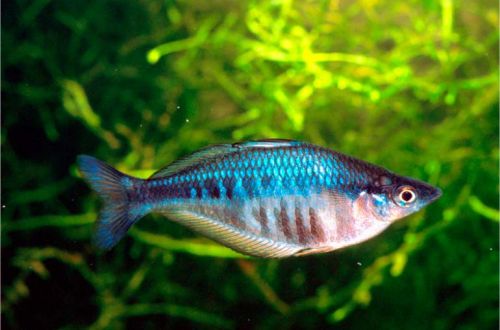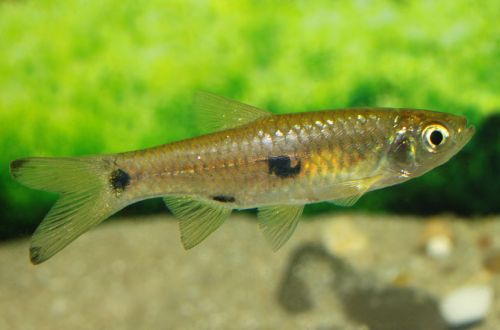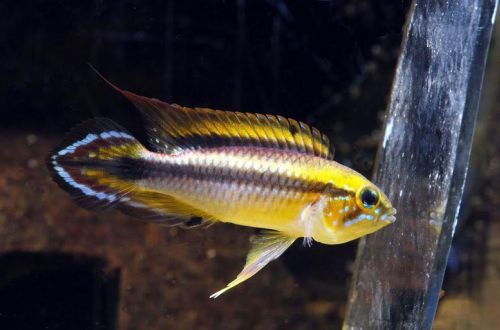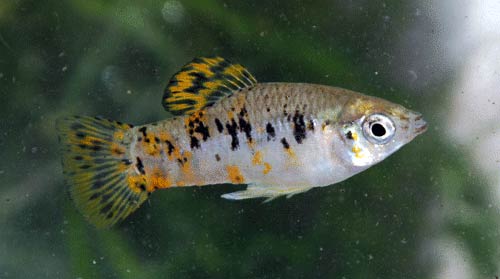
Cuban lime
Speckled limia, Limia striped or Cuban limia, scientific name Limia vittata, belongs to the family Poeciliidae (Peciliaceae or Gambusia). A popular aquarium fish, easy to keep and breed and can be recommended to beginner aquarists.

Contents
Habitat
The fish comes from the island of Cuba. It is found everywhere, inhabiting small streams, lakes, estuaries, coastal lagoons and mangrove swamps. Prefers to stay in shallow water with a lot of aquatic vegetation.
Brief information:
- The volume of the aquarium – from 60 liters.
- Temperature – 23-28°C
- Value pH — 7.0–8.0
- Water hardness – high hardness (19-30 dGH)
- Substrate type – any
- Lighting – moderate or bright
- Brackish water – recommended, 7-10 grams per 5 liters of water
- Water movement – light or moderate
- The size of the fish is 5–10 cm.
- Nutrition – any food with herbal supplements
- Temperament – peaceful
- Content alone, in pairs or in a group
Description
There are several color varieties of speckled limia. In home aquariums, fish with a body pattern of black and yellow specks on a gray and silver background are most often presented. They are significantly different from those that inhabit the waters of Cuba. On the island, the most common variety is the monochromatic olive-brown Limia. In nature, speckled forms are found only in a few regions, but they have become popular in the aquarium hobby.
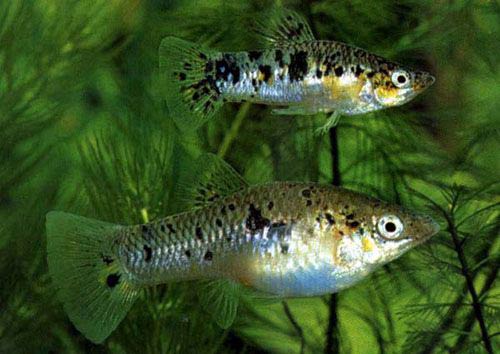
Sex differences are determined by the size of adult fish: females reach 10 cm, males rarely exceed 5 cm. If several males live in an aquarium, then an alpha male will appear among them, which is distinguished by more intense yellow specks.
Food
The daily diet can consist of a variety of products – dry flakes, granules, tablets, soluble capsules, freeze-dried, frozen or live invertebrates (brine shrimp, bloodworms, daphnia, etc.). The only important condition is the presence of herbal supplements in the feed. If algae grows in the aquarium, they will serve as an additional source of food.
Maintenance and care, arrangement of the aquarium
The optimal size of the aquarium for a group of 5-6 fish starts from 60 liters. The design should provide for places for shelters from thickets of live or artificial plants and areas of open water for swimming. When choosing plants, it is worth giving preference to species that can grow in an alkaline environment.

The Cuban limia is able to live in both fresh and brackish water, the latter being considered preferable. According to Ted Coletti, columnist for Tropical Fish Hobbyist magazine, fish do much better when salt is added, resulting in brighter colors and longer lifespans. The recommended salt concentration is 7-10 grams per 5 liters of water.
The main difficulties in maintenance are the maintenance of water salinity and high values of hydrochemical parameters. Over time, the water in the aquarium gradually softens, in order to prevent the pH and dGH values from dropping to critical levels, it is necessary to replace part of the water (30–40% of the volume) with fresh weekly, combining this procedure with cleaning the soil with a siphon from organic waste. It is permissible to use chemical filters with filter material that increases the hardness of the water.
Behavior and Compatibility
Peaceful friendly fish get along well with other non-aggressive species of comparable size. In nature, it lives in the same reservoirs with such popular aquarium fish as Mollies, Gambusia, Girardinus and others. Compatible with some Central American cichlids.
Breeding / breeding
In the artificial environment of the aquarium, the breeding season is not expressed, spawning occurs throughout the year. In favorable conditions, offspring appear every 4-6 weeks. Such large females can produce more than a hundred fry at a time. For example, in the middle of the 20th century in the Shedd Aquarium in Chicago, USA, the female Lymia striped gave birth to 242 fry! Parental instincts are not developed, there is no care for offspring. To protect juveniles from predation by adult fish, they should be transplanted into a separate aquarium.
Fish diseases
Finding the fish in a suitable habitat, getting them a balanced diet and free from external threats such as attacks from tankmates is the best guarantee against disease. The appearance of signs of illness can be a signal that there are problems in the content. Usually, bringing the habitat back to normal contributes to self-healing, but if the body of the fish has suffered too much, then medical treatment will be required. Read more about symptoms and treatments in the Aquarium Fish Diseases section.



